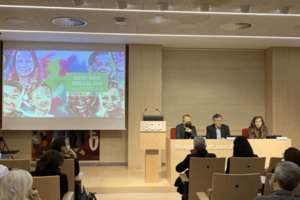Experts in nanomedicine come together to tackle rare diseases
The fourth edition of the "Nanorare Disease Day" event was held on February 28th, in collaboration between the Institut de Recerca Sant Joan de Déu de Barcelona and NanomedSpain, on World Rare Disease Day.
Rare diseases are those that affect fewer than 5 out of 10,000 people. Although this may seem like a small number, over 300 million people worldwide suffer from a rare disease. These diseases are mostly chronic and degenerative, leading to a disability in autonomy.
The Nanorare Disease Day event united around 90 people in person and online. It involved the views of the various actors involved in rare disease research, including companies, clinical practice, health authorities, patients, etc. Specifically, this year's speakers focused on explaining the latest advances in Cystic Fibrosis and Lysosomal Storage Diseases, particularly on Sanfilippo Syndrome.
The event was opened by Joan Comella, director of the Institut de Recerca Sant Joan de Déu (IRSJD) and Josep Samitier, director of the IBEC and scientific coordinator of the NANOMED Spain platform.
In Samitier's words, "Today, Rare Disease Day, is an opportunity to see how science, knowledge, and patients are involved in understanding these diseases. This is an event with several voices to raise awareness about the importance of investing in research, which allows us to progress."
Different voices with a common goal
The first talk was given by Josep Samitier, who spoke about the role of nanomedicine in diagnosing and treating rare diseases. Nanotechnology is the third-ranked of the so-called "enabling technologies," which increase the user's performance and capabilities. Some applications of nanomedicine are organs-on-a-chip and "mini-organs" or organoids. Both allow personalized in vitro studies on pathologies and drug efficacy for the patient.
Janet Hoenicka, a researcher at the Institut de Recerca Sant Joan de Déu, talked about using personalized therapies based on cellular and mouse models.
J. Pablo Salvador, from the Biomedical Research Networking Center (CIBER-BBN) and the Institute of Advanced Chemistry of Catalonia (IQAC-CSIC), spoke about the difficulty of quickly identifying bacterial infections, which are common in Cystic Fibrosis patients.
Maria del Mar O'Callaghan, from the Institut de Recerca Sant Joan de Déu (IRSJD), highlighted the possible applications derived from clinical research at the SJD Barcelona Children’s Hospital, which has Spain's first Pediatric Clinical Trials Unit.
Ibane Abasolo, from the Vall d'Hebron Research Institute (VHIR), delved into the treatments for Lysosomal Storage Diseases, specifically using artificial and natural nanoparticles.
The last two talks of the event focused on the needs of patients
Jordi Cruz, director of the MPS-LISOSOMALES Association, provided the patients' and their families' perspectives. Cruz, who created the association for his daughter born with Sanfilippo Syndrome, highlighted the importance of supporting families and patients and showing them they are not alone. "The doctor should prescribe an association to patients," he said.
Finally, Begonya Nafria Escalera, from the Institut de Recerca Sant Joan de Déu, explained the SJD Barcelona Children's Hospital model for incorporating the patient's voice into research. In their case, they have created various outreach materials so that children and families can better understand the diseases they live with. They also have initiatives in which the patients themselves carry out this outreach. "It is important to create materials by and for the patient, involve them," said Nafria.
More information
Expertos en nanomedicina se reúnen para hacer frente a las enfermedades raras. NanomedSpain.

Nanomedicine has the potential to contribute to solutions for so-called rare or diseases.
